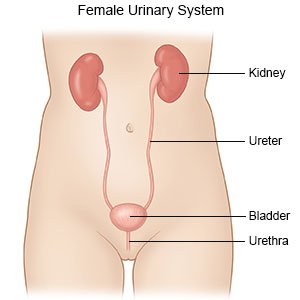Urinary Tract Infection in Pregnancy
Medically reviewed by Drugs.com. Last updated on Apr 6, 2025.
What is a urinary tract infection (UTI)?
A UTI is caused by bacteria that get inside your urinary tract. The urinary tract includes your kidneys and bladder. UTIs are common during pregnancy. This is because of changes in your immune system, hormones, and uterus. As your uterus grows, your bladder may not completely empty. Bacteria can grow in the urine left in your bladder and cause a UTI. UTIs during pregnancy can increase your risk for a kidney infection and preterm labor.
 |
What are the signs and symptoms of a UTI?
- Urinating more often, leaking urine, or waking from sleep to urinate
- Pain or burning when you urinate
- Pain or pressure in your lower abdomen
- Urine that smells bad
- Blood in your urine
How is a UTI diagnosed?
Your healthcare provider will ask about your signs and symptoms. Your provider may press on your stomach, sides, and back to check if you feel pain. You may also need any of the following:
- Urinalysis will show infection and your overall health.
- Urine cultures may show which germ is causing your infection.
How is a UTI treated?
- Antibiotics treat a bacterial infection.
- Medicines may be given to decrease pain and burning when you urinate or to decrease the urge to urinate often.
Treatment options
The following list of medications are related to or used in the treatment of this condition.
What can I do to prevent a UTI?
- Urinate when you feel the urge. Do not hold your urine. Urinate as soon as needed. Always urinate after you have sex. This helps flush out bacteria passed during sex.
- Drink liquids as directed. Ask how much liquid to drink each day and which liquids are best for you. You may need to drink more fluids than usual to help flush bacteria out of your urinary tract. Do not drink caffeine or carbonated liquids. These drinks can irritate your bladder. Your healthcare provider may recommend cranberry juice to help prevent a UTI.
- Wipe from front to back after you urinate or have a bowel movement. This will help prevent germs from getting into your urinary tract through your urethra.
- Do pelvic muscle exercises often. Pelvic muscle exercises may help you start and stop urinating. Strong pelvic muscles may help you empty your bladder easier. Squeeze these muscles tightly for 5 seconds like you are trying to hold back urine. Then relax for 5 seconds. Gradually work up to squeezing for 10 seconds. Do 3 sets of 15 repetitions a day, or as directed.
When should I seek immediate care?
- You are urinating very little or not at all.
- You have severe pain in your lower abdomen.
- You have a fever and chills.
When should I call my doctor or obstetrician?
- You have pain in the sides of your back.
- You do not feel better after 2 days of treatment.
- You are vomiting.
- You have questions or concerns about your condition or care.
Care Agreement
You have the right to help plan your care. Learn about your health condition and how it may be treated. Discuss treatment options with your healthcare providers to decide what care you want to receive. You always have the right to refuse treatment. The above information is an educational aid only. It is not intended as medical advice for individual conditions or treatments. Talk to your doctor, nurse or pharmacist before following any medical regimen to see if it is safe and effective for you.© Copyright Merative 2025 Information is for End User's use only and may not be sold, redistributed or otherwise used for commercial purposes.
Learn more about Urinary Tract Infection
- Antibiotic Resistance: The Top 10 List
- Antibiotics 101: Common Names, Types & Their Uses
- Antibiotics For UTI Treatment - What Are My Options?
- Antibiotics and Birth Control Pill Interactions
- Anticholinergic Drugs to Avoid in the Elderly
- Can You Drink Alcohol with Antibiotics?
- Common Side Effects from Antibiotics, and Allergies and Reactions
- Why Don’t Antibiotics Kill Viruses?
Treatment options
Medicine.com guides (external)
Further information
Always consult your healthcare provider to ensure the information displayed on this page applies to your personal circumstances.
